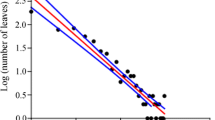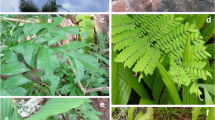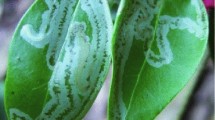Summary
The mining pattern of the honeysuckle leaf-minerPhytomyza lonicerae which feeds onLonicera gracilipes was analyzed with special reference to the avoidance of parasitoids' attacks. The leaf-miner makes the linear mine with branches and crosses by turning and branching, off the backtracking mine. Both average numbers of turnings and branchings were about 4. The speed of mining was 1.5 times faster in backtracking than in advancing. The mine width increased as the mining larva grew and total volume of consumed plant tissue was nearly constant independent of variability of the number of turnings and other characteristics of the mine. The majority of larval mortality were due to attacks by parasitoid wasps (Chrysochairs pentheus andDiglyphus minoeus), which locate the present position of leaf-miners, by tracing mine tracks, and wasps attack leaf-miners at a higher rate in backtracking than in advancing. The adaptive significance of branching and crossing by leaf-miners was discussed in terms of the reduction of parasitoids' attacks.
Similar content being viewed by others
References
Askew, R. R. (1968) A survey of leaf-miners and their parasites onLaburnum.Trans. R. Ent. Soc. London 120: 1–37.
Askew, R. R. andM. R. Shaw (1979) Mortality factors affecting the leaf-mining stages ofPhyllonorycter (Lepidoptera: Gracillariidae) on oak and birch. 1. Analysis of the mortality factors.Zool. J. Linn. Soc. 67: 31–49.
Inoue, T. (1983) Foraging strategy of a non-omniscient predator in a changing environment. (1) Model with a data window and absolute criterion.Res. Popul. Ecol. 25: 81–104.
Hering, E. M. (1951)Biology of the leaf-miners. Uitgeverji Dr. W. Junk. Hague.
Hassell, M. P. andT. R. E. Southwood (1978) Foraging strategies of insects.Ann. Rev. Ecol. Syst. 9: 75–98.
Murai, M. (1974) Studies, on the interference among larvae of theCitrus leaf-miner,Phyllocnistis citrella Stainton (Lepidoptera: Phyllocnistidae).Res. Popul. Ecol. 16: 80–111.
Papentin, F. (1973) A darwinian evolutionary system. III. Experiments on the evolution of feeding patterns.J. Theor. Biol. 39: 431–445.
Price, P. W. (1975) Reproductive strategies of parasitoids. InP. W. Price (ed)Evolutionary strategies of parasitic insects and mites. Plenum, New York.
Raup, D. M. andA. Seilacher (1969), Fossil foraging behavior: Computer simulation.Sci. 166: 994–995.
Sasakawa, M. (1961) A study of Japanese Agromyzidae (Diptera). 2Pacif. Insects 3: 307–472.
Spencer, K. A. (1976)Fauna entomologica Scandinavica. vol. 5. The Agromyzidae (Diptera) of Fennoscandia and Denmark. Scandinvian Science Press LTD. Klampenborg, Denmark.
Sugimoto, T. (1977) Ecological studies on the relationship between theRanunculus leaf-mining fly,Phytomyza ranunculi Schrank (Diptera: Agromyzidae) and its parasiteKratochivilina sp. (Hymenoptera: Eulophidae) from the viewpoint of spatial structure. 1. Analysis of searching and attacking behaviors of the parasite.Appl. Ent. Zool. 12(2): 83–103.
Trägardh, I. (1909) Zur Kenntnis vonPhytomyza, Xylostei Kltb. eine inLonicera Symphoricarpus minierende Fliege.Z. Wiss. Insekt-Biol. 5: 301–304.
Author information
Authors and Affiliations
Rights and permissions
About this article
Cite this article
Katô, M. Mining pattern of the honeysuckle leaf-minerPhytomyza lonicerae . Res Popul Ecol 26, 84–96 (1984). https://doi.org/10.1007/BF02515509
Issue Date:
DOI: https://doi.org/10.1007/BF02515509




